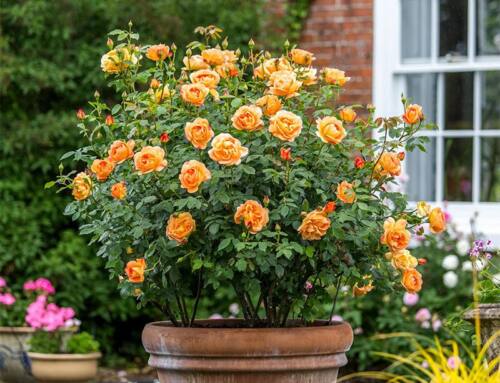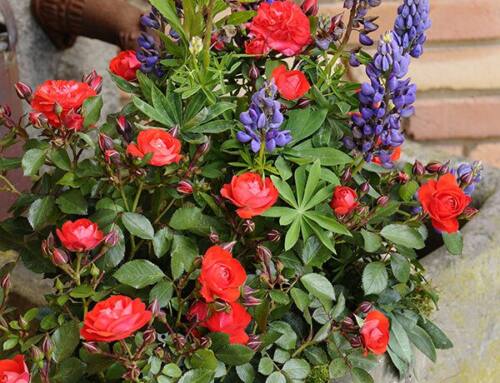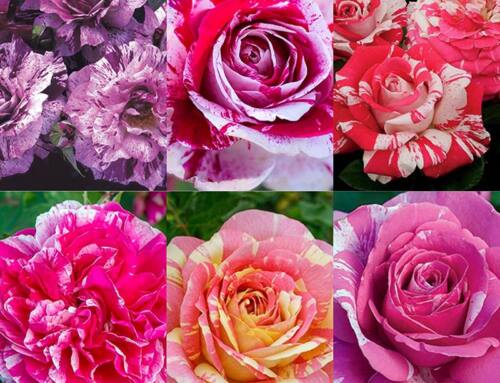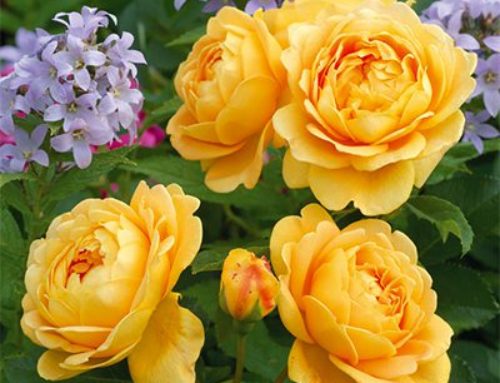How to Grow Climbing and Rambling Roses
A climbing rose makes a wonderful plant choice when you have a wall, fence or pergola to cover with foliage, flowers, and fragrance. Climbing roses offer a wide range of flower and fragrance types in almost every colour of the rainbow. Not only can they soften vertical surfaces, but they can also add extra beauty and romance to your garden or patio.
With hundreds of different cultivars available, it can certainly make choosing even more difficult in the case of climbing as well as rambling roses. While both types need support for their long canes, there are some key differences in these two groups of roses.

What are the differences between climbing and rambling roses?
Climbing roses:
– are less vigorous growing
– provide singular, larger flowers sprinkled throughout the entire plant
– typically repeat bloom in waves throughout the season from June until fall
– have stiffer canes with less flexibility
– bloom on new wood
Rambling roses:
– are more vigorous growing
– have smaller flowers that form in clusters throughout the entire plant often followed by nice rose hips
– typically flower once a year in June (though there are exceptions)
– have more flexible canes that allow for easier wrapping around structures
– bloom on old wood
How long will it take for my climbing or rambling rose to establish?
Keep in mind that most climbing and rambling roses need at least 2-3 years to establish before they can begin to attain their full growth potential.
Make sure to provide rich compost, ample water, and fertilizer. A transplant fertilizer should be applied to provide nutrients and rooting hormone during initial establishment followed later in the season and subsequent years by a good quality rose fertilizer.
During the first season after planting, lots of growth will occur but most of it will take place below ground. Your rose will be working on establishing a strong root system to support future upward growth. Above ground, you’ll still see some stem growth and flowering but year one will feel like a slow start.
Typically, by the third year your rose should be tall, luscious, and full. From year four onwards, it will continue to get fuller and more impressive year after year.
How do I choose between a climbing or a rambling rose?
Most gardeners opt for a climber over a rambler as they want repeat flowering throughout the season, however, there are ramblers that are repeat flowering such as David Austin’s Malvern Hills and The Albrighton Rambler. Those who are looking for low maintenance can consider a rambler as they bloom on old wood and require less pruning. The rambler’s flexible canes can be used to carefully wrap around a column, large tree, or archway without fear of cane breakage. A climbing rose can be more difficult to train and require more pruning, however, its showy, multiple waves of repeat-blooming, large flowers make them more popular than their counterparts.

Malvern Hills is a David Austin rambling rose bearing pale yellow and creamy white flowers with medium fragrance. Unlike other rambling roses, it will rebloom through the season.

The Albrighton Rambler is a reblooming David Austin rambling rose with dense blush pink rosettes and light fragrance.
How do I prune climbing and rambling roses?
Climbing or rambling roses require different pruning and deadheading techniques to encourage flowering and keep plants healthy, manageable and with a pleasing structure.
During the growing season, spent flowers on ramblers can be cut back or left to form rose hips except for repeat-flowering ramblers which should be deadheaded to encourage rebloom. Climbing roses should be deadheaded throughout the season to encourage successive waves of flowers.
Ramblers can be pruned in late summer or early fall or they can be pruned along with climbers in early spring. Remove dead, diseased, or dying canes by cutting them to the base near the ground. New, unbloomed shoots (typically bright green) will bloom in their second year, so maintain these stems as they will provide the upcoming season’s flowers. You can also trim side shoots by two thirds and cut back tips by a couple of buds to encourage branching and more flowers. As ramblers are vigorous growers, established plants can become very thick and dense over the years. Old canes can be cut down to the base to create more space if needed. With full sized, mature plants you can also trim down one third of the canes each season starting with the oldest.
For climbers, major pruning is best done after the last frost, just before spring growth begins. At this point, the rose will have long since shed its leaves which will assist in identifying the canes. Remove dead, diseased, or dying canes by cutting them to the base near the ground. Weak canes any thinner than a pencil should be removed. Keep the main, strong canes and trim their side shoots back to about two inches or five centimetres maintaining one strong bud. Tie new stems to create a well spread out framework that will provide a nice display when in flower and maintains good air circulation through the foliage. If plants become congested after many years, trim out some of the oldest canes.
How do I get more flowers from my climbing and rambling roses?
Of course, full sun, rich soil, ample water, and good fertilizing are of paramount importance but here’s a fun tip: training both climbers and ramblers to grow horizontally will encourage the plant to produce more flowers on the side shoots along the entire cane, rather than long, tall octopus-like canes with flowers just at the tips. Be careful when training stems horizontally to avoid snapping off the main canes. New shoots are softer, more malleable, and easier to work with.
Should I plant companion plants with my climbing or rambling roses?
The strong stems and woody framework of climbing and rambling roses make a great support to grow complimentary vines with and through your roses to add extra layers of colour, flower contrast, and fragrance. Honeysuckles, jasmines, and clematis, all make great companions that will grow through your rose popping out with flowers that may bloom at the same time as the rose flowers or may maintain the show after your rambler is done flowering for the season or between flushes on your climbing rose.

You can also plant perennials and groundcovers at the base of your roses. As long as you are providing ample water, good soil, and abundant fertilizer, there will be enough resources to go around allowing all plants to thrive.
In general, perennial companions should not be taller than 2-3 feet (60-90 cm) so as not to obscure the rose flowers. Any number of perennial plants could be used including Campanula, Astrantia, Agastache, Alstroemeria, summer-blooming, non-bulbous Allium, stonecrops, and Salvia. Avoid plants such as Monarda and Phlox which can be susceptible to powdery mildew which could also affect your rose.
When it comes to ground covers, it’s important to choose the right growth type since you’ll want to be applying compost each year to maintain soil fertility and water holding capacity for your rose. Use rhizomatous or running ground covers that can handle the addition of compost in spring like sweet woodruff (Galium odoratum), Ajuga, Fragaria, lily-of-the-valley, Bergenia, and Epimedium. Or use mass-planted clumping plants like Brunnera, Hosta, Heuchera, Pulmonaria, and hellebores to form a ground cover around the base of your rose. Since black spot and powdery mildew spores can often infect plants by splashing up onto leaves from the soil during a rainstorm, planting ground covers at the base of your roses can help keep your plants healthier.
What are the top ten best climbing roses?
There are so many beautiful options in climbing roses and everyone has their preferences for colour and fragrance. But here are our top ten staff picks for climbing roses:










At Phoenix Perennials we carry a wide selection of roses each year for British Columbian and Canadian gardeners, with a particular focus on English-style and David Austin roses, Brad Jalbert roses, and roses from other top breeders like Kordes, Meilland, and Weeks. We offer them for pre-order starting in the summer and running through the fall and winter with regular launches as our suppliers confirm our orders. In the spring these are provided potted for local customers or shipped bare root across Canada. Extra roses are then available for sale in the nursery from spring through fall. Make sure to sign up for the Rose Alert to be the first to know about the Great Rose Pre-Order and all things roses at Phoenix Perennials. We’ll send you occasional updates on our roses and email you first when our pre-orders launch.
Give Your Garden the Phoenix Perennials Touch:
At Phoenix Perennials we offer over 5000 different plants every year for in-person shopping at our garden centre and plant nursery in Richmond, British Columbia. Additionally, we offer more than 3000 different plants each year for mail-order shipping across Canada. Stay connected with our diverse offerings and all things Phoenix Perennials by signing up for our E-Newsletter and Alerts and engaging with us on social media. Happy gardening!




